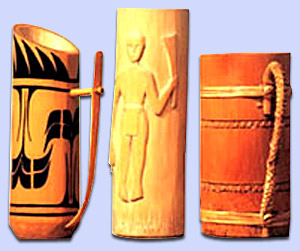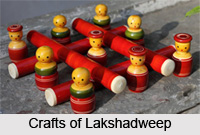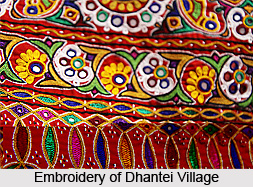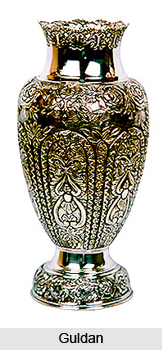 Surahis (flasks) and guldans (flower vases) have survived in sufficient numbers to allow one to attempt to classify them along chronological and geographical lines. They also seem to have been curiously significant in Islamic culture, especially in Iran and India. Along with that related vessel, the ewer or aftaba (a water vase with handle and spout), they enjoyed the status of a motif in the visual arts and a topos in both sacred and profane literature.
Surahis (flasks) and guldans (flower vases) have survived in sufficient numbers to allow one to attempt to classify them along chronological and geographical lines. They also seem to have been curiously significant in Islamic culture, especially in Iran and India. Along with that related vessel, the ewer or aftaba (a water vase with handle and spout), they enjoyed the status of a motif in the visual arts and a topos in both sacred and profane literature.
Surahis and Guldans are displayed with great prominence in the wall niches in the background of imperial Mughal paintings, as in "The Death of Inayat Khan" where they are used as important elements of design in an otherwise stark: composition. The actual architectural niches in surviving palaces are sometimes shaped like bottles, as in the Ali Qapu in Isfahan. And very often, especially in India, entire palace walls are decorated with designs of long necked flasks, or shorter flower vases, sometimes painted in an indigenous fresco technique, sometimes inlaid in semi-precious stones, or carved in low relief as in the early seventeenth-century palaces at Sikandra, the Suraj Bhan ka Bagh and the Kanch Mahal. Such motifs may originally have had a connection with the "waters of fertility" - and hence with good fortune and abundance - but it is doubtful if by this time they were seen as anything more than elegant shapes.
Several flasks probably date from the late sixteenth or early seventeenth century, although they are from different regions of the subcontinent. One has the attenuation of the vases carved in relief on the palaces at Sikandra and Fatehpur Sikri and therefore must have been made in north India. The neck is very long and at the summit there is a widening, like a miniature cup, which probably was meant to have had some sort of cover or stopper, the vases sculpted on the walls of the palaces at Sikandra have exactly the same cup-like widening at the top. A vase of similar type with an elongated neck and a cup-like summit has superb dark paint; if anything, this has an even more restrained and harmonious form. A third piece, with a long neck and an elegantly ridged body, still retains most of its original surface tinning. A fourth flask can be ascribed to the same group, with a similar flared neck but lacking the cup-like summit.
A brass flask is said to have been found at Golconda, a provenance supported by its thick, honey-coloured brass and sensuously rounded shape. It must date from the early seventeenth century.
Several thickly cast surahis are marvels of concise, elegant design. One has a dramatic, rippled surface like tightly twisted rope. Diagonal ridging is a profoundly Indian kind of surface articulation for metal objects. The most impressive example of this trait is on the Butler brass ewer, where swirled surfaces attained a rare elegance. A small flask combines similar swirled surfaces on its belly with parallel horizontal ridging on its rather short neck. Its compact, completely unflamboyant shape and its sensitively rendered, almost "fleshy" knob or kumbha at the junction of the neck and the belly inclines one to place this piece in the sixteenth or early seventeenth century.
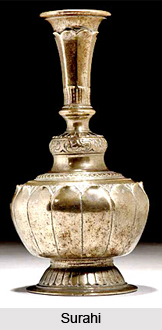
However, the most exciting flask to use swirled ridging for its surface articulation is a very large bronze piece. Although it perhaps does not attain the extraordinary level of elegance of the Butler brass ewer, it nevertheless displays an impressive form and size. The diagonal ridging is of an especially deep and vigorous kind which harmoniously unites the belly neck and lid, producing an unusual masterpiece of sleek, uncluttered design.
A number of bidri surahis have survived. The earliest, heaviest and most robust piece is either a huqqa of unusual form or the surviving belly of a giant flask missing its neck and lid. This surviving part, for which an early seventeenth-century date can be ventured, has a marvellously bulging, globular shape - which, in a typically Indian way, evokes the fullness of a ripe fruit. The surface decoration consists of vertical rectangular panels separated by arabesque, each panel containing large-scale meanders of flowers and leaves interspersed with Chinese clouds, the whole achieving an architectural monumentality rare in the decorative arts.
Another early bidri flask is probably early seventeenth-century although the possibility of a late sixteenth-century date cannot be excluded. It is dramatically articulated with sharply angled flanges on the body and diagonal ridging on the neck, the latter reminiscent of a number of early flasks and ewers. Each segment is inlaid with energetic meanders of split-leaf palmettes, quatrefoils and trefoils. The latter motifs, in particular, are strongly reminiscent of late Timurid ornament, raising the possibility of a very early date for this remarkable bidri object.
The most finely inlaid bidri flask has impeccably drawn poppies in brass and silver. It is related to a superb huqqa which shares some of the small details of ornament and which may be the work of the same seventeenth-century Bidar craftsman.
Another flask has chequerboard ornament from medieval Hindu sources, inserted between bands of lappets derived from the Mughal acanthus. An example with figural decoration of palm trees, pleasure pavilions and jungle life is certainly from the same eighteenth century Bidar workshop as the huqqa which narrates the Padmavat story. A late 18th century piece uses European neo-classical motifs in a confident and original manner, much like the huqqa.
A surahi engraved with romping cows and tri-lobed arches in a rustic but energetic manner is one of the few vessels bearing a useful inscription. Very different from the styles current in the rest of the subcontinent was the metalwork of Kerala. It was characterised by refined austerity, and it was also very rare. Very little has survived - other than the boldly ithyphallic lotas called kindi and a small group of flasks.
A large brass bottle may be a simple palace water container, as it is said to have come from a royal source in Rampur. The gadrooned body and circle of acanthus leaves round the short neck are typical of late eighteenth-and early nineteenth-century design. It must once have had some kind of cork or stopper. Although this piece cannot be earlier than the eighteenth century, the bottom-heavy shape with its distinctively short tapering neck must have been the classic royal water container form in both India and the Middle East, as attested by an early sixteenth-century Iznik vessel.



